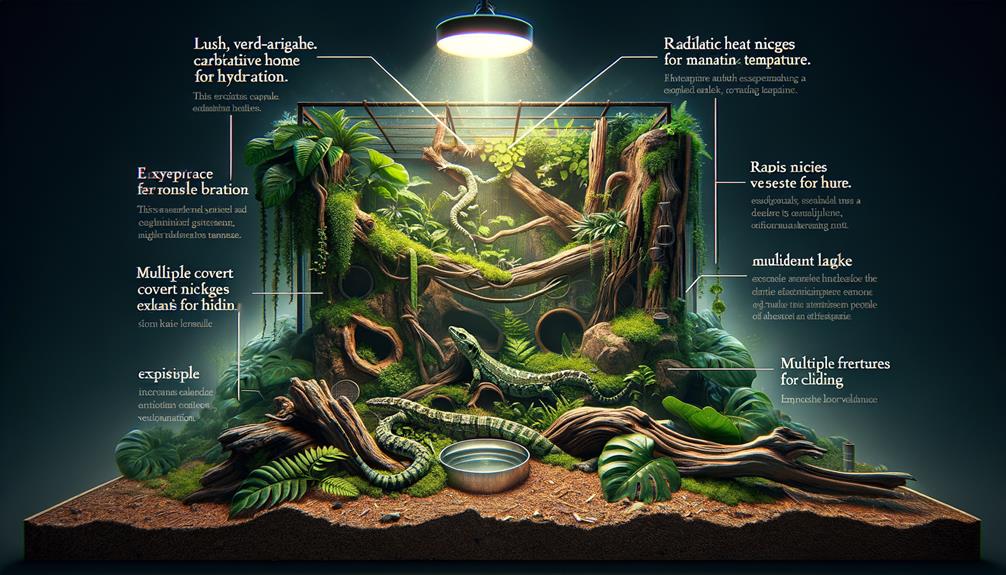Understanding reptile lighting and UVB needs is crucial for their health and well-being. Without proper UVB light, reptiles can’t synthesize Vitamin D3, which is vital for calcium absorption and preventing metabolic bone disease. Effective lighting also regulates their behavior, daily rhythms, and overall health.
When choosing UVB bulbs, opt for high-quality options like Reptisun. Make sure to maintain a proper distance (9-15 inches) and replace them every 9-12 months. It’s also important to create lighting zones tailored to your reptile’s specific species requirements. By doing so, you’ll create a thriving environment for your reptile. To learn more about reptile lighting, keep reading to gain a deeper understanding of this critical aspect of their care.
Key Takeaways
Reptiles require UVA and UVB light to synthesize Vitamin D3 and absorb calcium. UVB bulbs, such as Sun Glow and Reptisun, are crucial for mimicking natural sunlight. For optimal effect, place UVB bulbs 9-15 inches from your reptile. Different species have unique lighting needs, so research specific requirements to ensure optimal health. Replace UVB bulbs every 9-12 months to maintain effective UV exposure.
Importance of Lighting
Proper lighting is vital for reptiles as it regulates their behavior, helps them synthesize essential vitamins, and establishes their daily rhythms for eating and sleeping. In my experience, using the right light sources can significantly impact a reptile’s health. Reptiles require both UVA and UVB light to produce Vitamin D3, which is crucial for calcium absorption. Without proper lighting, they struggle to absorb calcium, leading to severe health issues.
Natural sunlight is the ideal source, but replicating it indoors requires specific lighting solutions. I use UVB bulbs, such as those from Zoo Med, to ensure my reptiles get the UV exposure they need. These bulbs mimic natural sunlight and provide the necessary UVA light. However, it’s crucial to remember that UV output decreases over time. I replace these bulbs every 3,500 hours to maintain optimal UV exposure.
Selecting the right bulbs and fixtures is as important as understanding the unique needs of different reptile species. Proper lighting reduces stress and prevents negative responses, making it just as crucial as food and water for creating a healthy, stress-free environment for my reptiles.
Understanding UV Light
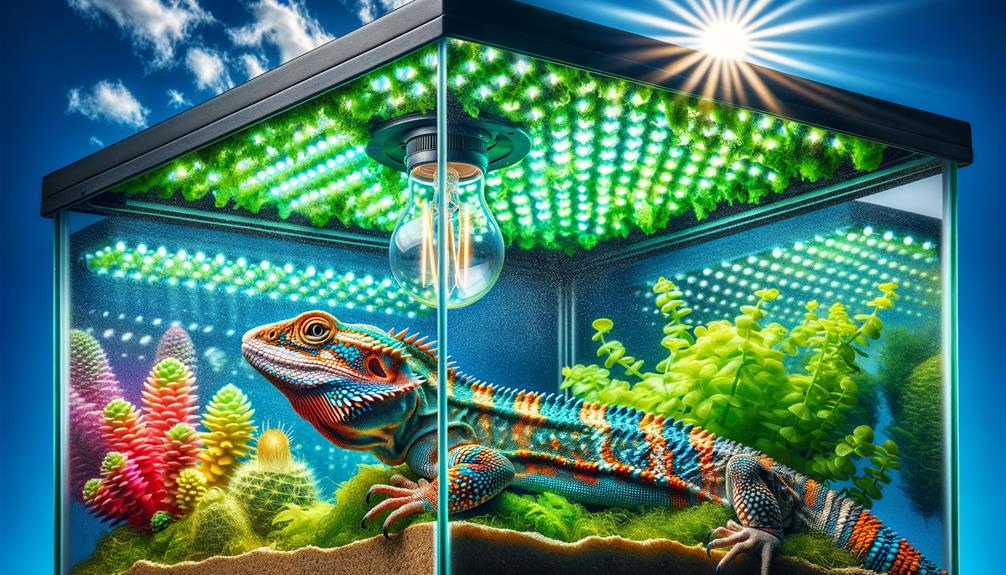
UV light, specifically UVB, is vital for reptiles to synthesize Vitamin D3, which is essential for calcium absorption and overall health. Without adequate UVB light, reptiles struggle to produce Vitamin D3, leading to impaired calcium absorption and potentially severe health issues, including metabolic bone disease. This condition, characterized by weakened bones and deformities, highlights the critical importance of UVB exposure in reptiles.
In the wild, reptiles bask in sunlight to meet their UV exposure needs, but in captivity, artificial lighting must replicate these conditions to ensure proper reptile health. Effective lighting and UVB needs require providing the right spectrum and intensity of UV radiation. Certain products, such as Sun Glow, Reptisun, Iguana Light, Power Sun, and Repti Glo lamps, are designed to meet these requirements. By providing the right UVB light sources, we can prevent metabolic bone disease, promote calcium absorption, and maintain overall reptile health, ensuring our reptilian companions thrive in their environments.
Choosing the Right Fixture
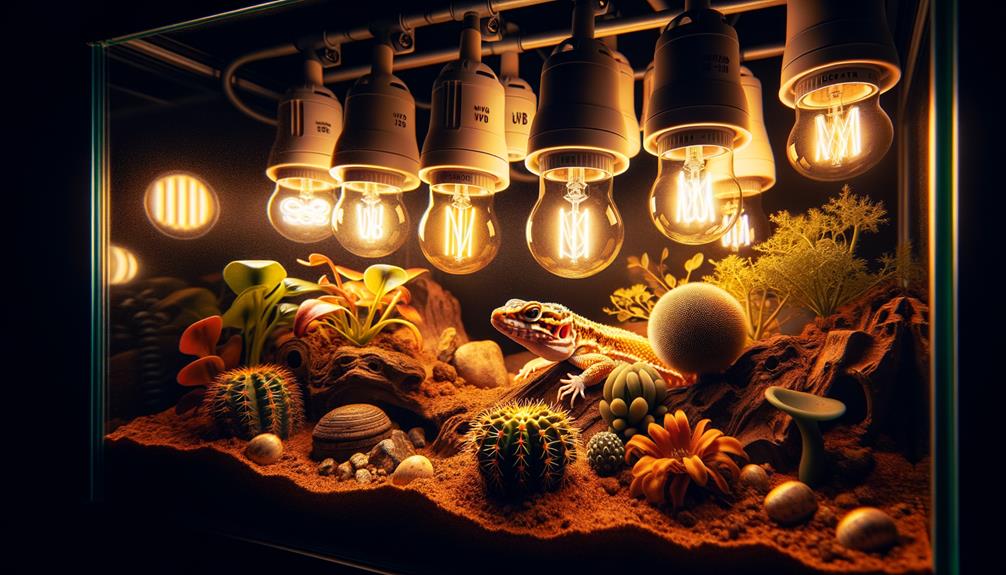
When selecting a lighting fixture for your reptile, it’s crucial to consider the specific needs of the species. Different reptiles have unique requirements, so researching these needs is vital. For instance, UVB bulbs are essential as they provide the necessary ultraviolet light for calcium metabolism and overall health. Make sure to use these UVB bulbs during the day and turn them off at night to mimic natural sunlight patterns.
When it comes to heat, choose a fixture that accommodates both UVB and heat source bulbs. Some fixtures are designed to hold dual-bulb setups, providing both essential UVB and the heat needed to maintain proper body temperature. Nighttime heat sources, such as black or red bulbs, are effective for providing warmth without disrupting the reptile’s sleep cycle.
The size of the terrarium also plays a critical role in the selection process. Larger terrariums may require more powerful bulbs or additional fixtures to ensure consistent lighting and heating throughout the habitat. Consulting experts and conducting thorough research can help you select the best lighting fixture tailored to your reptile species and terrarium size. This approach ensures your reptile thrives in an environment that closely replicates its natural habitat.
Reptile Lighting Zones
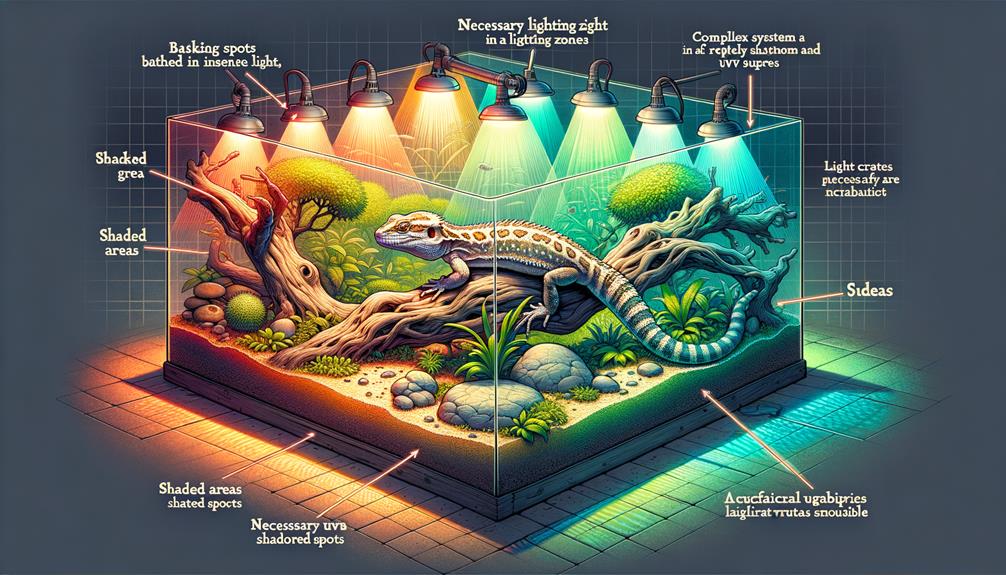
Implementing reptile lighting zones is crucial to replicate the natural UV exposure that different species require for optimal health. The Ferguson Zones categorize the UV Index needed by various reptiles based on their natural habitats, ensuring each species receives the best UV lighting. This methodical approach is vital for anyone aiming to provide top-notch care for their reptiles.
Understanding these zones allows me to customize UVB lights to fit the specific needs of each reptile species. For example, a species that thrives in open, sunny environments will require higher UV exposure compared to one that inhabits dense forests. The Ferguson Zones provide a structured framework, making it easier to determine the appropriate UVB output, which is vital for reptile health.
Proper placement of UV lighting, aligned with these zones, ensures reptiles in captivity receive the same UV benefits they would in the wild. This precise replication of natural conditions helps prevent health issues like metabolic bone disease. By following the principles of the Ferguson Zones, I can ensure the best UV exposure, promoting the overall well-being and vitality of my reptiles.
UVB Bulb Placement
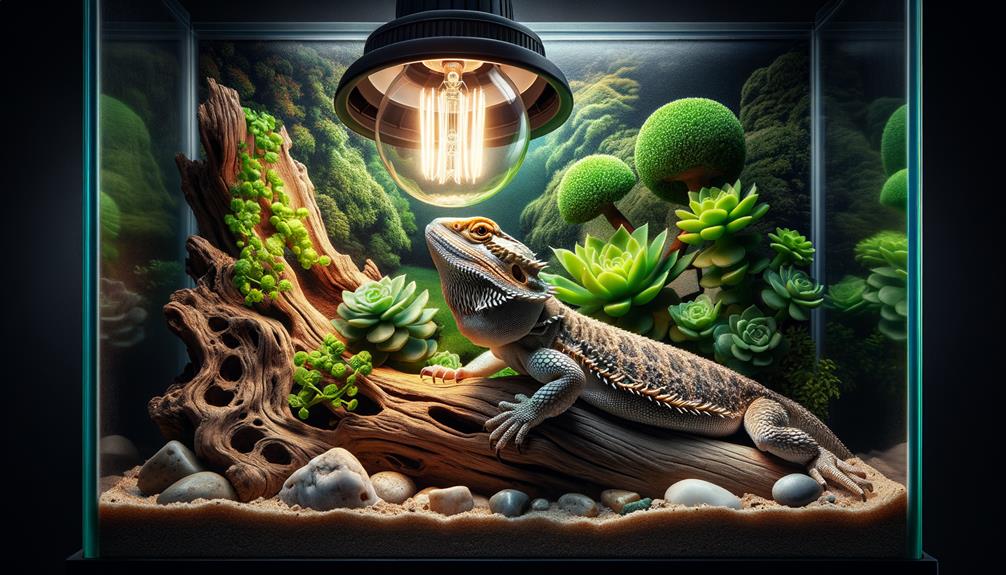
Positioning UVB bulbs at the right distance is crucial for reptiles to receive the necessary amount of ultraviolet exposure for their health. Placing UVB bulbs 9-15 inches away from the reptile is vital to ensure effective exposure while preventing skin damage.
The following table highlights key aspects of UVB bulb placement:
| Distance | Effect | Action |
|---|---|---|
| 9-15 inches | Effective exposure | Maintain proper distance |
| < 9 inches | Potential skin damage | Increase distance |
| > 15 inches | Ineffective UVB exposure | Decrease distance |
It’s equally important to ensure that UVB bulbs are unfiltered, as any filtering can significantly reduce the effectiveness of the UV rays, potentially leading to health issues in reptiles. Close proximity to UVB light can be harmful, so maintaining the recommended distance is crucial.
UVB bulbs also lose their effectiveness over time and should be replaced every 9-12 months. Regular replacement ensures that reptiles continue to receive the best level of UV exposure, which is vital for their health and vitality. By following these guidelines, we can create a thriving environment for our reptiles.
Frequently Asked Questions
What Kind of Lights Give off Uvb?
UVB lights are a must-have for reptile owners, and specialized bulbs like Sun Glow, Reptisun, Iguana Light, Power Sun, and Repti Glo lamps are designed to provide the essential UV-B wavelengths (290-320nm) that reptiles need to thrive. To get the most benefit, position these bulbs within 9-15 inches of your pet.
Do I Need a Basking Light and a UVB Light?
If you want your reptile to thrive, you need to provide it with the right environment. That means using both a basking light and a UVB light. The basking light gives your reptile the heat it needs, while the UVB light helps its body produce vitamin D3.
How Long Does an UVB Light Need to Be On?
UVB lights should be on for 10-12 hours a day, mimicking the natural sunlight cycle. This duration allows reptiles to produce vitamin D3 and regulate calcium absorption, while turning them off at night helps maintain a natural day-night cycle.
What Is the Purpose of a UVB Light?
The purpose of a UVB light is to help reptiles make Vitamin D3, which is crucial for absorbing calcium. Without it, they can develop metabolic bone disease and have trouble growing strong bones. In short, UVB light is vital for their health and well-being.


